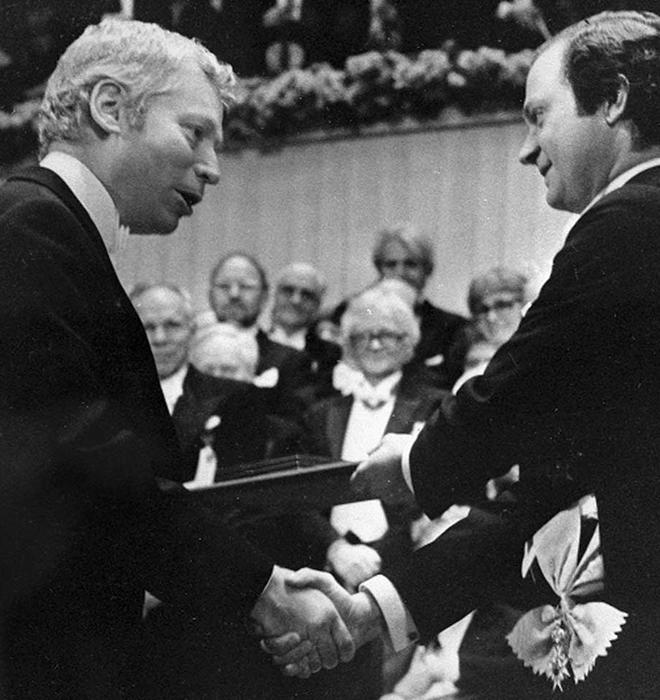
May 3, 1933 – July 23, 2021
In the world of science, Steven Weinberg *57 was a celebrity — not just for winning the 1979 Nobel Prize in Physics, but for the way he could bring the most complex ideas about the universe down to earth.
Weinberg was an icon among physicists; when he died, obituaries noted his transformative impact on the field. He won the Nobel, with two others, for demonstrating that two of the fundamental forces in the universe — electromagnetism and the weak force, which is responsible for radioactivity — are the same: a breakthrough discovery that became a pillar of the Standard Model of physics, which classifies all known elementary particles. But some of Weinberg’s 10 books were not written for fellow academics; rather, they’re for mainstream readers who appreciate the wonder of science and mathematics — perhaps an equally important piece of his legacy.
“I certainly wouldn’t criticize people who don’t write for the public, but I do have some admiration for those who do,” Weinberg told interviewer David Wilkinson in 2015. “After all, we get [financial] support from the public and we justify that by describing scientific advance as part of the advance of civilization. … [W]hen we talk about science as part of the culture of our times — well, we’d better make it part of that culture by explaining what we’re doing.
“You have to keep in mind that you’re writing for people who are not mathematically trained but are just as smart as you are,” he continued. He noted that he’d heard from some readers who went on to become scientists after reading his explanations, and said: “That pleased me more than any other praise could possibly do.”
Physicist Edward Witten *76, a professor at the Institute for Advanced Study, met Weinberg when Witten was a postdoctoral fellow at Harvard in 1976. He recalls Weinberg’s interventions during “family meetings,” where faculty and students discussed topics in elementary particle physics: “When a topic would come up at one of those meetings which he suspected many or most of us did not understand well, he would give a little lecture explaining his understanding.” Soon, the others began to understand, too.
Weinberg, the first in his family to go to college, at Cornell, said he first found the power of mathematics “intoxicating” when, in high school, he managed to calculate the shape of the cables holding up a suspension bridge. He spent most of his physics career as a professor at the University of Texas at Austin — he was still teaching last spring, at 87.
To his students, Weinberg was not only an inspiring and tirelessly productive scholar, but also a caring mentor. Raphael Flauger, who completed his Ph.D. under Weinberg, was teaching in the department when a family emergency pulled him away. Without hesitation, Weinberg offered to teach in his place. “I will always remember how self-evident it seemed to him that he should offer to teach my course even though he was already 82 years old,” Flauger says. Another former student, Joel Meyers, remembers him as “deeply kind and surprisingly funny.”
Weinberg’s wife, Louise, a professor of law, emerita, at UT Austin, describes him as a “polymath” who had “an enormous fund of knowledge — of history and politics (all nations, all eras), poetry, music, art, cities, streets … . ”
Louise Weinberg says her husband saw his work as a process of refining past discoveries into an increasingly precise and simplified form. “He liked to believe that there is a sense in which the triumphs of the past, of Galileo, Newton, Maxwell, Einstein, held good, and were cumulative,” she says. “He thought, if the process had an end, it would be the discovery of the ultimate laws of nature.” Weinberg brought us one step closer to discerning those laws.
Joanna Wendel ’09 is a regular contributor to PAW.
Watch a World Science Festival documentary about Steven Weinberg *57:






2 Responses
Zelek S. Herman *71
3 Years AgoChance Meetings
An egregious error occurs in the caption to the photograph accompanying the otherwise excellent obituary of Steven Weinberg *57 (“ ...receives Nobel Prize in Physics from Norwegian King Carl Gustaf in December 1979,” February issue). Only the Nobel Peace Prize is presented in Norway. All of the other Nobel Prizes are presented in Stockholm by Swedish King Carl XVI Gustaf.
I had the pleasure of being introduced to Weinberg in the elevator of the physics department at the University of Texas in 1985 while visting my dear friend Jacob D. Bekenstein *72 (of blessed memory; PAW April 6, 2016). I can never forget Weinberg's red hair.
Even earlier, in the summer of 1975, while I lived in Sweden, I met His Majesty at the Linnaeus Gardens in Uppsala. My comment to the King was “Good day, Your Majesty.” His response, with a smile: “Good day!”
Also in 1975, I met Bekenstein’s Ph.D. adviser, John Archibald Wheeler, at the entrance of the main university building when Wheeler was being presented with an honorary doctorate by Uppsala University. Many people feel that Wheeler should have been awarded a Nobel Prize in Physics.
btomlins
3 Years AgoFor the Record
The caption for Steven Weinberg *57’s photo in the February issue misidentified King Carl Gustaf. He is king of Sweden.